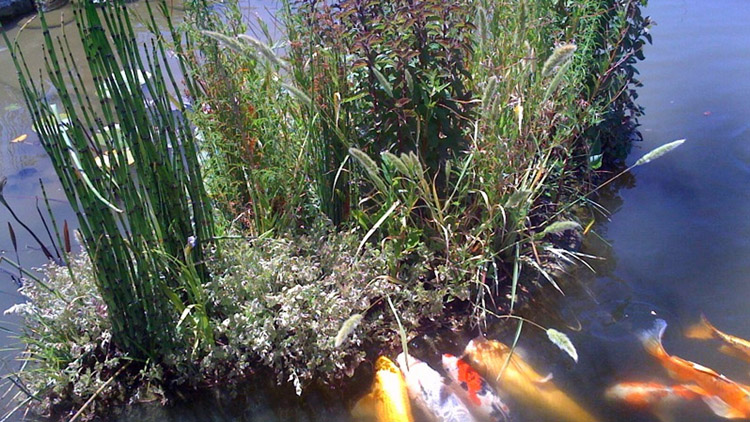 During my boyhood years I was fortunate to spend summers on a farm that was located near the confluence of two rivers. The water table was high and the soil was rich and fertile. There were many ponds on the property, and they all held fish—very large fish that never seemed interested in the bait I was presenting!
During my boyhood years I was fortunate to spend summers on a farm that was located near the confluence of two rivers. The water table was high and the soil was rich and fertile. There were many ponds on the property, and they all held fish—very large fish that never seemed interested in the bait I was presenting!
The only logical way I could figure to get a better look at these fish was to snorkel among them. I dove beneath the surface of one clear pond and felt like a part of the happy waters—the thriving fish habitat, the frogs kicking to the surface, the waving plants— feeling cool currents as water flowed into the pond.
I remember how wonderful the clean pond water felt to swim in and how the water teemed with life. Green growth was abundant on the rock surfaces. I found most of the life and plant growth where the overhanging banks projected pond plants and tree roots into the water.
The fish that were swimming there had plenty of places to hide, from my hooks, yes, but also from birds who would prey on them. They seemed to have an unending food supply in the roots of the plants. It was evident to me, even as a child, that most of the life in the pond hung out where the water was clearer, cleaner and full of food and other life—near the overhanging banks.
“You don’t clean water in hope of resurrecting the food web, you resurrect the food web in order to clean water.”
Adventures like this inspired my lifelong curiosity of water and its biology, but life intervened. Long summer days swimming with the fish in the happy waters eventually came to an end. My dream of one day owning my own pond, however, persisted.
A different kind of pond
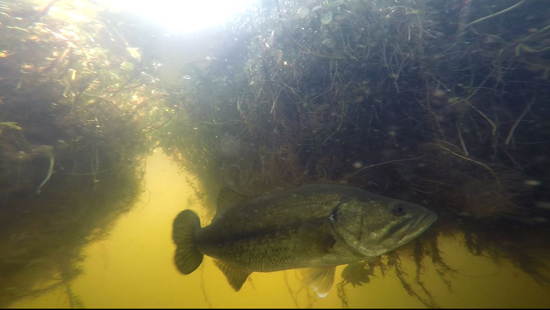
The days of dreaming what it would be like to be a pond owner came to an end when my wife and I inherited a nearby pond close to our place of business. Our new pond was about 2.5 acres, the recipient of ground water during the rainy season. Its depth went from 15 feet to a little more than half that in the dry summer. It would be a long time before I could attempt to catch a fish here, however. This was not a pond of happy water; rather, it held retained water for grazing cattle. It was full of excess nutrients and needed algae control. Despite this, when we first visited it, it was home to many turtles. With the change of seasons, especially the heat from the warming sun, a horrendous growth of algae, and a particularly unpleasant smell plagued it. The water turned green, and the turtles disappeared.
My challenge: To make this pond happy. The pond smelled bad. The pond was green. Could I ever bring a year-round, natural, thriving habitat for fish and frogs and turtles here?
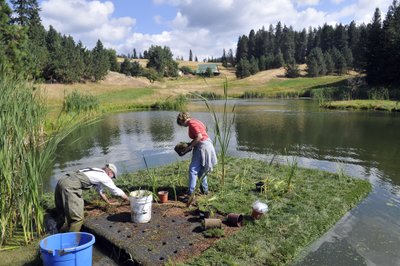 During the rainy season, a complex assortment of nutrients and the runoff of fertilizer and pesticides wash into the pond. In the dry summer months, the water is being drawn down and the temperature of the water rises. The elements that exist in the water, including ammonia, nitrogen, and phosphorus, need somewhere to go and something to do, so, left to their own devices, they bind together to form algae, which blooms and smells terrible. In many situations this algae will use all the available dissolved oxygen in the water—compromising every oxygen-dependent life form. Fish need oxygen. Algae blooms also create dangerous toxins.
During the rainy season, a complex assortment of nutrients and the runoff of fertilizer and pesticides wash into the pond. In the dry summer months, the water is being drawn down and the temperature of the water rises. The elements that exist in the water, including ammonia, nitrogen, and phosphorus, need somewhere to go and something to do, so, left to their own devices, they bind together to form algae, which blooms and smells terrible. In many situations this algae will use all the available dissolved oxygen in the water—compromising every oxygen-dependent life form. Fish need oxygen. Algae blooms also create dangerous toxins.
What could be done?
- We could try to minimize the pond’s exposure to excess nutrients, but this is difficult in an agricultural area as well as heavily landscaped settings.
- We could add copper sulfate, but this is temporary and expensive, and doesn’t control the primary cause of the problem. This also poses risks to humans, livestock, and wildlife, in addition to harming a variety of non-target aquatic organisms.
- We could add aeration to the pond. This requires bringing out a source power like solar or electricity.
- We could plant trees around the pond to provide shade for the pond, but this will take many years to have an effect.
- We could add a water-based dye to the pond to provide shade, but even the best of these still cause massive discoloring of waterfowl, fish and amphibians.
- We could find another source of shade for the water.
- We could create circulation in the pond.
- We could introduce beneficial bacteria and microbes into the pond to help reduce prior years’ storage.
- We could resurrect the food web.
Remembering those ponds from my youth, the happy waters, where the fish hung out in the clear clean water, thriving in the roots and shade of the overhanging banks, I knew the solution lay back there somewhere. My happy water had natural circulation, shade, and a healthy bounty of food for every part of the food chain. Ideally, a combination of different strategies would create the best solution for our pond. What we needed was to find the opportunity to mimic the nature of a healthy pond ecosystem.
Though it would be amazing to bring it to the level it’d need to be for a pleasant moonlit swimming experience, we were going to be satisfied with simply eradicating the smell and the terrible toxic excretions of the algae bloom.
Who is Bruce Kania?
Kania is at the fore of the movement using biomimetics for pond care and lake maintenance. As a boy, he was a fishing guide in the floating peat bogs that surrounded his northern Wisconsin home. When he could no longer ignore the destruction of wetlands and waterways caused largely by the excess nutrients from agricultural runoff, Kania brought together a team of scientists, engineers, horticulturalists and botanists, to find a way to mitigate the problem. Their solution was to duplicate nature’s processes—biomimetics.
They created a matrix made of recycled plastic bottles (keeping all those plastic bottles out of landfills!) and used that bulky matter, which looked an awful lot like nature’s own surface area, to create islands capable of supporting the weight of plants and soil. The recycled fibers within the matrix allowed water to pass through, and also proved to be excellent material for growing biofilm—the key features of a wetland. This allowed unwanted nutrients to be “eaten” by bacteria forming on the island and in the plant roots. In 2005, Kania opened the doors of his floating island business: Floating Island International, where he offers many ways to get involved in the work of cleaning the world’s water, ranging from citizen science on the islands to internships and partnering for sales or manufacturing. Now, he runs a Research and Development Company.
A Lesson in Biomimetics
Biomimetics is the field of science in which inspirations are elicited from nature to design practical materials and systems that can imitate structure and function of native biological systems.
Scientists researching ecological restoration note the healthy food webs that exist in wetlands. They have been keyed into the idea of mimicking wetlands’ ability to
- increase the surface area so that biofilm generating bacteria can uptake nutrients
- restore the food web so that nutrients can cycle up
- create shade and hiding places for fish not unlike those that occurred along the edges of that happy pond of my youth.
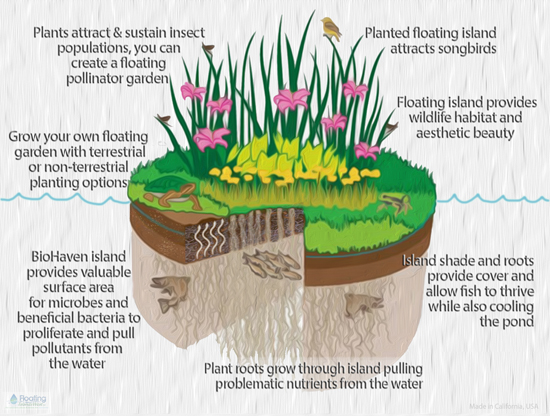
Then it can be fished. Fishing is the final step in the healthy ecosystem of a pond.
Over $3 million has been invested in research through the Center for Biofilm Engineering at Montana State University and the National Institute of Water and Atmospheric Research in New Zealand. By biomimicking nature, floating islands provide a “concentrated wetland effect” that transitions nutrients up the food chain. Instead of nutrients short‐circuiting into monocultures of algae, floating islands provide substrate—the enhanced surface area that transitions nutrients from periphyton (the microbial and algae community attached to underwater surfaces) to fish.
Over 9,000 biomimetic floating islands have been launched around the planet over the past decade, in New Zealand, Singapore and the U.S.
In a TEDxTalk from 2018, an innovator named Bruce Kania said: “You don’t clean water in hope of resurrecting the food web, you resurrect the food web in order to clean water.” Kania’s reasoning resonated with me. If the pond wasn’t bringing the joy of a healthy ecosystem to me, I’d do my best to bring it to the pond.
What did we do?
After doing our research, we invested in Biohaven floating islands. Floating islands are an innovative green technology for water resource recovery. We added pond plants to a number of sizes of islands ranging from 25 square feet to 250 square feet and deployed them in our pond. We strategically placed the islands in the areas where the algae was heaviest.
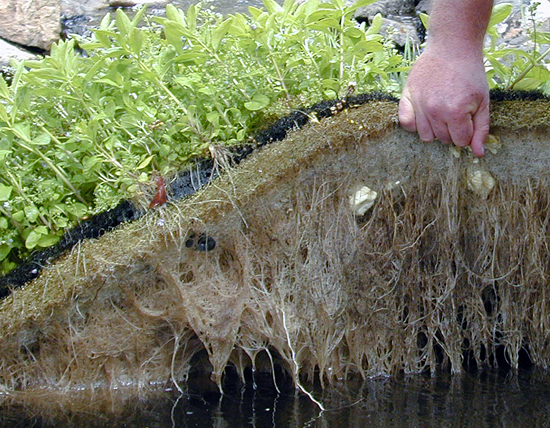
After just a few days, the roots of the plants were already growing through and out the bottom of the islands into the heart of the nutrient storage of our pond. Water around the islands cleared almost immediately. Within a day the bio-film had attracted enough suspended solids to clear the column of water to see down two or three feet. Initially we did nothing more than just watch the dramatic changes.
This plant growth and clearing water around the island continued, and we saw more algae control. We could see small fish swimming near and under the island within the developing root zone. We watched development of colonies of microbes and then the bugs, birds and fish eating them. After a couple of months, we saw turtles basking in the sun on top of the islands.
My wife and I have found much joy in environmental stewardship and bringing our pond back to health, and are happy to have discovered the biomimetic—nature mimicking—way to manage pond care.


Hi.
What kind of plants go on the island? Could I plant my watermelons on it? And if I did, how would I pick them?
Thanks,
Robin
Answer from Laddie Flock:
Thank you Robin. It is interesting that many terrestrial plants do well on the island. I like using Sedge and Rush Varieties as well as wetland grasses primarily for their massive root structure which grows out the bottom of the Island. I have never seen or heard of Watermelons on an island but would think they would do very well and carefully on the harvest. Lad
This is such a great article, and love how you wrote the story!! I imagine a lot of very happy plants, fish and little kids playing in the water.
Answer from Laddie:
You have captured the vision. The Science and Education of this technology is so encompassing and deliberate. Ever changing, never the same. Lad